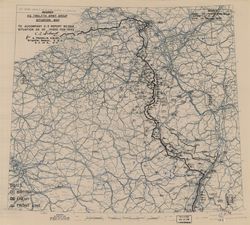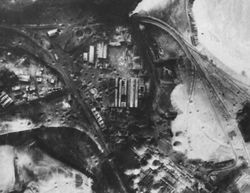 |
Lou Prucha WWII Service
|
 |
Mechernich, Germany
(Repair Depot)

Pilot's Flight Log |

12th Army Group Situation Map 14-Feb-1945 |
piloting 668 Bomb Sq. A-26B-20-DL Invader, Serial # 41-39274, Fuselage code 5H-S.
Click to display the official 416th Bomb Group Mission Folder, Mission Report and Operational Report
scanned to PDF files by the Air Force Historical Research Agency (AFHRA).
The Mission photo above is from Wayne Sayles' 416th Bomb Group website, 416th Bomb Group mission # 204 page.
Lt. Chalmers' (668th Bomb Squadron) aircraft and crew (Lt. Eckard and S/Sgt. Fortner) was lost on this mission (MACR 12346).
Group, Unit and Historical Extracts for Mission 204
"416th Bombardment Group (L) - Group History 1945"
Transcribed from USAF Archives
Two missions took off to attack targets in Germany on the 14th. In the morning, the armored motor vehicle repair depot at Mechernich was attacked. The first box, led by Col Willetts, with Lts Royalty and Basnett as B and N, dropped on their PPF plane. The leader of the second box, Capt Pair, with Lts Corum and Pair as B and N, was unable to release his bombs. He peeled away form the formation after he had attempted a second run on Gee equipment unsuccessfully. The deputy leader took over and led the box east toward the Rhine, where he made a sweeping turn and headed back to our lines. The second box encountered moderate to intense accurate flak from the moment it left the target area until it reached friendly territory. Ten aircraft suffered battle damage. The eleventh aircraft, believed hit by flak, was last seen going down in flames in the vicinity of Heinersheim. One chute emerged. The crew of three included Lts J.J. Chalmers and L.W. Eckard, and S/Sgt K. Fortuner. Photos showed a large freight station severely damaged and two smaller buildings damaged. At least 15 goods wagons were badly damaged or burned out, and three rail lines in the sidings were knocked out. At least two hits were scored on the roof on well camouflaged concrete buildings which were partly underground.
"Attack Bombers, We Need You! A History of the 416th Bomb Group"
Ralph Conte
Pages 207 - 208
Mission #204 - 14 February - AM - Mechornish Motor Transport Repair Depot. Colonel Willetts, Lts. Royalty and Basnett as the BN team in Box I, with Captain Pair with Lts. Corum and Muir in Box II. - Lt. Colonel Napier with Lts. Conte and Kupits as BNs, and Lts. Anderson and Babbage, BN,- Lt. Chalmers with Lt. Eckard, BN, led flights with Lts. Stanley and Blount, BN flew deputy. Heavy, accurate flak at the target met the group. The first box leader dropped their bombs on PFF. Captain Pair's ship experienced mechanical failure, so they didn't drop. He turned away from the formation, with the deputy taking over and trying to bomb a secondary target. He led the box toward the Rhine River, then made a wide turn toward our lines, crossing over some heavy anti-aircraft guns, damaging ten planes flying in his box. Lt. Chalmers, Lt. Eckard, BN and gunner S/Sgt. E. Fortuner took a direct hit and went down in flames. One chute, believed to be Lt. Chalmers, was seen to open. Eckard and Fortuner were listed as MIA. Photo recon showed the target was pretty well damaged, with a large freight station severely damaged, and two smaller building being hit. Baggage cars were badly damaged and burned out, three rail lines were knocked out. At least two hits were scored on the roof of a well camouflaged concrete building. So, bombing through PFF is not all that bad! This was Lt. Conte's 65th mission, feeling lucky not to have been injured on this last combat sortie.
"Operational History 668th Bomb Squadron (416th Bomb Group (L)) WWII"
Wayne Williams, et.al.
14th February Ė today was the first time we flew two missions from A-69. In the morning was Group Mission # 204, with six crews flying from our squadron. Andersen & Babbage led the third flight of the second box, while Stanley & Blount acted as deputy box leaders, flying A-1-2. Lt. Chalmers & Lt. Eckard, with Gunners Fortner went along, on what was destined to be their last mission. The target was the prime mover depot at Mechernich. It proved to be a "hot" target, and heavy accurate flak was encountered. The whole formation received flak, and in the case of Chalmers it was the payoff. He was last seen going down in flames. A parachute was seen, which gave hope that someone was able to get out. Who it was remains a question. All of the planes in the formation received flak damage in varying degrees of severity. Lt. Babbage, B/N for Capt. Andersen, had a piece of flak come thru the nose of the plane, missing him narrowly. The fact that he was bent over the bombsight saved him from serious injury, if not death. The formation returned to the base after a three-hour flight. The results on the mission were undetermined at the bombs were dropped on PFF.
"668th Bombardment Squadron (L) History"
Transcription from USAF Archives
On the morning of 14 February, heavy enemy ground fire was encountered over Machernich. Lieutenant John J. Chalmers and his crew were reported Missing in Action (see Item 4 above).
The afternoon of the same day, the new team of Major Price and Lt., Forma scored a "Superior" in an attack on Rheinbach Ammunitions Depot. Lt., Hand, Major Price's regular bombardier, was grounded due to a non-battle casualty (broken ankle).
"History of 670th Bombardment Squadron (L)"
Transcription from USAF Archives
Two missions were flown of the 14th. In the morning the Mechernich Prime Mover Depot was bombed. Eight of our crews were on the mission. They ran into intense heavy accurate flak after they left the target, which continued until they reached the bomb line. One of the ships in the formation was hit and went down in flames. Photoreconnaissance later showed that rail lines, buildings and cars were severely damaged and burned out.
"671st Bomb Squadron (L) Unit History"
Gordon Russell and Jim Kerns
The Ninth Bomb Division had its biggest day since Christmas 1944 on February 14th, 1945 and the 416th Group was in the midst of it, running missions against heavily defended targets. In the morning Col. Willetts and Capt. Pair led the Group against the Prime Mover Depot at Mechornich. The Colonelís box bombed on PFF and bursts were seen through the clouds near to the DMPI. A mechanical failure on Captain Pairís ship prevented him from bombing, but many of the ships in his box dropped on different targets in enemy territory.
The deputy box leader took over the lead from Captain Pair when his ship failed to bomb, and he overshot the target area. The deputy ran into flak from several hot targets and the planes were badly shot up. Lt.Chalmers, his bombardier and gunner went down in this barrage which lasted fifteen minutes. The leader finally got clear. Eleven ships were battle-damaged.
The Skelton crew, which worked relentlessly to get the planes ready for the morning mission, were put to test again when the Group was alerted for another mission that afternoon. The ground and aircrews who had loaded the planes that morning with 500 pounders had the arduous task of throwing 250 pounders into the bomb bays for the second mission.
The planes were dispatched against the ammunition reserves at Rheinbach, 10 miles southwest of Bonn. A Pathfinder was once again sent, but it was unable to contact its station and the bombing was changed to visual. The first two flights chalked up superior results with the center of bursts 215 feet from the DMPI.
The third flight in the first box hit a town near the primary, after failing to drop on the first run. The second box bombed in one pattern, with the bombs hitting on the edge of the target area. Explosions indicated that ammunition was hit.
Flak was intense accurate over the target. Twenty planes received battle damage, but all returned.
"USAAF Chronology of WWII, month by month"
TACTICAL OPERATIONS (Ninth Air Force): In Germany, 600+ A-20s, A-26s, and B-26s attack rail bridges, a marshalling yard, communications centers, an ammunition dump, a prime mover depot, and several targets of opportunity in morning and afternoon missions aimed primarily at obstructing enemy movement and supply; fighters fly armed reconnaissance over wide areas, escort the bombers bombers, attack river traffic, bridges, and other targets, and support US Third Army elements E of the Our and Sauer Rivers.
